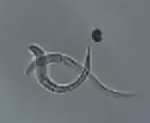What are they?
C elegans are nematodes (worms), which are commonly found in soil from across the globe. Their usual diet consist of microorganisms bacteria.
Anatomy of C. elegans:
C. elegans posses a small number of internal organs and tissues. These internal organs operate the essential parts of the body. The head contains the brain and the prominent feeding organ – the pharynx. The main body is filled with the intestine and in the case of an adult hermaphrodite the gonad consisting of the uterus and spermatheka. During the gastrulation stage C. elegans reproduce, embryos develop inside the female ” mother” and laid through the vulva.
C. elegans body is a cylindrical shape that is enclosed by layer of epithelial cells (hypodermis). A secreted cuticle protects these Cells that consist of proteins (mainly collagens). The main body of the C elegans walls muscle cells are separated into four sections in the dorsal and ventral areas. Similar to the spinal cord on the human body, major nerve cords transverse the entire length of the body. The pseudocoelomic space is a fluid like substance that surrounding the intestine and gonad. C. elegans completely lacks skeletal elements and has no circulatory system. Adult C. elegans measure approximately 1mm in length, and roughly about .2mm in diameter. This unique physical makeup allows oxygen from the air to diffuse through the body. Nutrients from the gut are disperse into the pseudocoelmic space and taken up by other cells. C. elegans body possessive internal pressure called hydrostatic. This pressure imitates as a hydrostatic skeleton. C. elegans Muscle cells are firmly attach to the external cuticle. When muscle Contract cells, this reaction corresponds to bending of the rigid body.
The life Cycle of C. elegans
When C. elegans produce embryos, they are developed and hatch after 14 short hours. The first stage is the larval. Completion of this stage is reached after 12 hours, and C. elegans proceed to the “four molt cycles” before reaching adult stage. When Larva is faced with adverse conditions such as under crowded or absence of food, larvae can choose an alternative developmental pathway. This alternative pathway can sustain the larva for several months. If the larva detects better living conditions, it switches back to normal development. C elegans exit the dauer larval stage in which they develop into the normal fourth larval stage before becoming adult. Adult C. elegans are hermaphrodites and produce eggs and sperm. It is estimated that 300 eggs are laid in a 3-4 day period. However, life span of C. elegans is a mere 2-3 weeks. This short generation cycle facilitates genetic experiments and is a major advantage for researchers working with this organism.



